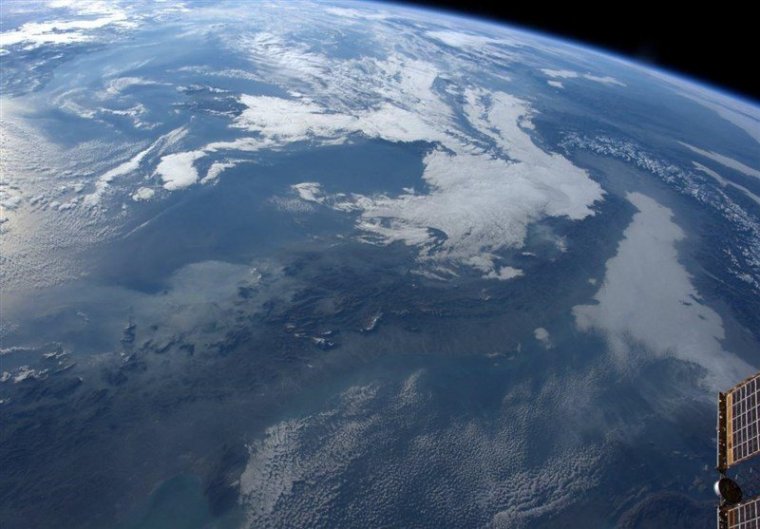| News / Science News |
Earth’s Days Mysteriously Increasing in Length
Precise astronomical observations, combined with atomic clocks, have revealed that the length of a day is suddenly getting longer. Scientists don’t know why.

Earth’s Days Mysteriously Increasing in Length. Photo: tasnimnews.com
This has critical impacts not just on our timekeeping, but also on things like GPS and other precision technologies that govern our modern life.
Earth’s rotation around its axis has been speeding up over the past few decades. Since this determines how long a day is, this trend has been making our days shorter. In fact, in June 2022 we set a record for the shortest day over the past half a century or so.
However, despite this record, since 2020 that steady speedup has curiously switched to a slowdown. Now, days are getting longer again, and the reason so far remains a mystery.
While the clocks in our phones indicate there are exactly 24 hours in a day, the actual time it takes for Earth to complete a single rotation can vary ever so slightly. These changes sometimes occur over periods of millions of years, and other times almost instantly. For example, even earthquakes and storm events can play a role.
It turns out that a day is very rarely exactly the magic number of 86,400 seconds.
Earth’s rotation has been slowing down over millions of years due to friction effects associated with the tides driven by the Moon. That process adds about 2.3 milliseconds to the length of each day every 100 years. A few billion years ago, an Earth day was only about 19 hours.
For the past 20,000 years, another process has been working in the opposite direction, speeding up Earth’s rotation. When the last ice age ended, melting polar ice sheets reduced surface pressure, and Earth’s mantle started steadily moving toward the poles.
Just as a ballet dancer spins faster as they bring their arms toward their body – the axis around which they spin – our planet’s spin rate increases when this mass of mantle moves closer to Earth’s axis. This process has been shortening each day by about 0.6 milliseconds each century.
Over decades and longer, the connection between Earth’s interior and surface comes into play too. Major earthquakes can change the length of day, although normally by small amounts.
For example, the Great Tōhoku Earthquake of 2011 in Japan, with a magnitude of 8.9, is believed to have sped up Earth’s rotation by a relatively tiny 1.8 microseconds.
Apart from these large-scale changes, over shorter periods weather and climate also have important impacts on Earth’s rotation, causing variations in both directions.
The fortnightly and monthly tidal cycles move mass around the planet, causing changes in the length of day by up to a millisecond in either direction.
We can see tidal variations in length-of-day records over periods as long as 18.6 years. The movement of our atmosphere has a particularly strong effect, and ocean currents also play a role. Seasonal snow cover and rainfall, or groundwater extraction, alter things further.
Since the 1960s, when operators of radio telescopes around the planet started to devise techniques to simultaneously observe cosmic objects like quasars, we have had very precise estimates of Earth’s rate of rotation.
A comparison between these measurements and an atomic clock has revealed a seemingly ever-shortening length of day over the past few years.
This has critical impacts not just on our timekeeping, but also on things like GPS and other precision technologies that govern our modern life.
Earth’s rotation around its axis has been speeding up over the past few decades. Since this determines how long a day is, this trend has been making our days shorter. In fact, in June 2022 we set a record for the shortest day over the past half a century or so.
However, despite this record, since 2020 that steady speedup has curiously switched to a slowdown. Now, days are getting longer again, and the reason so far remains a mystery.
While the clocks in our phones indicate there are exactly 24 hours in a day, the actual time it takes for Earth to complete a single rotation can vary ever so slightly. These changes sometimes occur over periods of millions of years, and other times almost instantly. For example, even earthquakes and storm events can play a role.
It turns out that a day is very rarely exactly the magic number of 86,400 seconds.
Earth’s rotation has been slowing down over millions of years due to friction effects associated with the tides driven by the Moon. That process adds about 2.3 milliseconds to the length of each day every 100 years. A few billion years ago, an Earth day was only about 19 hours.
For the past 20,000 years, another process has been working in the opposite direction, speeding up Earth’s rotation. When the last ice age ended, melting polar ice sheets reduced surface pressure, and Earth’s mantle started steadily moving toward the poles.
Just as a ballet dancer spins faster as they bring their arms toward their body – the axis around which they spin – our planet’s spin rate increases when this mass of mantle moves closer to Earth’s axis. This process has been shortening each day by about 0.6 milliseconds each century.
Over decades and longer, the connection between Earth’s interior and surface comes into play too. Major earthquakes can change the length of day, although normally by small amounts.
For example, the Great Tōhoku Earthquake of 2011 in Japan, with a magnitude of 8.9, is believed to have sped up Earth’s rotation by a relatively tiny 1.8 microseconds.
Apart from these large-scale changes, over shorter periods weather and climate also have important impacts on Earth’s rotation, causing variations in both directions.
The fortnightly and monthly tidal cycles move mass around the planet, causing changes in the length of day by up to a millisecond in either direction. We can see tidal variations in length-of-day records over periods as long as 18.6 years.
The movement of our atmosphere has a particularly strong effect, and ocean currents also play a role. Seasonal snow cover and rainfall, or groundwater extraction, alter things further.
Since the 1960s, when operators of radio telescopes around the planet started to devise techniques to simultaneously observe cosmic objects like quasars, we have had very precise estimates of Earth’s rate of rotation.
A comparison between these measurements and an atomic clock has revealed a seemingly ever-shortening length of day over the past few years.
But there’s a surprising reveal once we take away the rotation speed fluctuations we know happen due to the tides and seasonal effects. Despite Earth reaching its shortest day on June 29, 2022, the long-term trajectory seems to have shifted from shortening to lengthening since 2020. This change is unprecedented over the past 50 years.
The reason for this change is not clear. It could be due to changes in weather systems, with back-to-back La Niña events, although these have occurred before. It could be increased melting of the ice sheets, although those have not deviated hugely from their steady rate of melt in recent years.
Could it be related to the huge volcano explosion in Tonga injecting huge amounts of water into the atmosphere? Probably not, given that occurred in January 2022.
Scientists have speculated this recent, mysterious change in the planet’s rotational speed is related to a phenomenon called the “Chandler wobble” – a small deviation in Earth’s rotation axis with a period of about 430 days. Observations from radio telescopes also show that the wobble has diminished in recent years. Perhaps the two are linked.
One final possibility, which we think is plausible, is that nothing specific has changed inside or around Earth. It could just be long-term tidal effects working in parallel with other periodic processes to produce a temporary change in Earth’s rotation rate.
Precisely understanding Earth’s rotation rate is crucial for a host of applications – navigation systems such as GPS wouldn’t work without it. Also, every few years timekeepers insert leap seconds into our official timescales to make sure they don’t drift out of sync with our planet.
If Earth were to shift to even longer days, we may need to incorporate a “negative leap second” – this would be unprecedented, and may break the internet. (Tasnim News Agency)
YOU MAY ALSO LIKE





